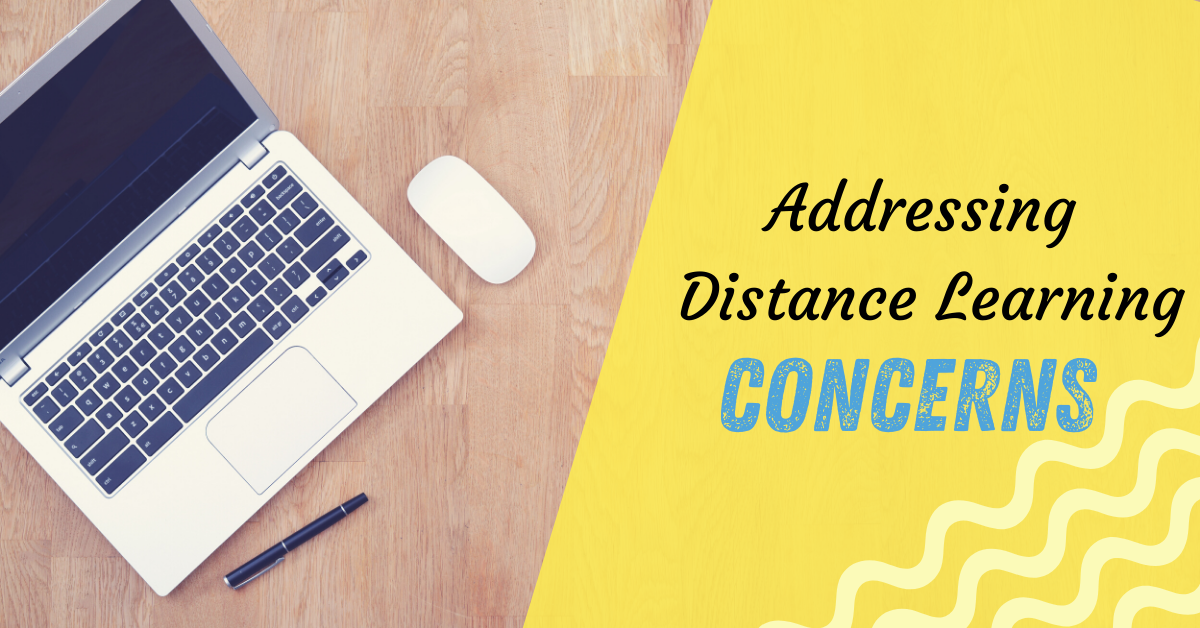Addressing Distance Learning Concerns
As we are quickly discovering, distance learning has its share of challenges. There’s new technology to navigate, lessons and assignments to adapt for use outside of the classroom, near-constant questions and clarifications, and that’s just the tip of the iceberg. The biggest challenge is that for most of us, distance learning is new and scary, and it has come upon us quickly. We’ve been thrown into the metaphorical deep end, and we’re trying to stay afloat.
As we navigate this different way of learning, teachers and students alike are dealing with various fears and concerns that may have arisen in these uncertain times. These may include:
- Dealing with tech issues (audio/video lag during live classes, ability to upload or share materials with students, ability to submit work using various platforms or apps)
- For teachers, how to adjust current materials and lesson plans to accommodate distance learning, or make up entirely new material; for students, how to receive, understand, and complete this material
- Teachers trying to encourage student participation and engagement during live class time; students dealing with obstacles to participation (shared device, lack of reliable internet, no privacy to participate, background noise, etc.)
- Managing school/home life balance
- Missing out on a “real” school production (or trying to figure out how to put on a “virtual” production, and dealing with pushback or disinterest)
- Worries about the future (will distance learning become the “new normal,” will students continue on in drama studies, will this affect post-secondary pursuits, will graduation happen, and so on…)
- Dealing with mental health concerns (feeling overwhelmed, underprepared, self-doubting, unmotivated, stuck, stressed out, confused, anxious, exhausted, etc.)
How do we stay positive and not dwell on the negative? Read on for some tips and advice to help you on your distance learning journey. We hope they help to address your fears and concerns as well as your students’.
1. You’ve dealt with new, stressful, and/or unknown situations before, and survived.
You are more experienced and resilient than you give yourself credit for. While nobody has dealt with this exact situation before, you have succeeded in difficult situations in the past, and have grown and learned lessons to get you to where you are today. Let’s look back on those times. Try this exercise with your students
- Set a timer, and write for three minutes about how you feel right now when you think about your current distance learning situation. Take note of any thoughts, emotions, or physical sensations you experience. Do this in a stream-of-consciousness style – you can write in full sentences, or simply write down words, phrases, or even doodles of what’s going on in your brain. Get it all out on the page.
- Think back to a time when you felt similarly. Describe the situation or event that caused those feelings. What happened? What was the final result? How did you cope? How did that situation or event affect you going forward?
- If the situation had a negative result, what did you learn from it? How could you apply that learning to how you feel now? If the situation had a positive result, how can you duplicate that result now?
You can get this exercise in worksheet form at the bottom of this page.
2. You’re not going to have all the answers. Be honest and forthcoming with your students.
Presumably, distance learning is not only new to your students, but is new to you too. Remind your students that you’re all learning together. When questions or problems arise that you don’t know the answer to or have an immediate solution for, say so. See if you can resolve the problem together, or let your students know that you’ll find out as quickly as you can and get back to them. Once you and/or your students find or create a solution, write it down or add it to a virtual FAQ page, so you and your students can refer to it if a similar question or situation occurs in the future.
It may help to share your own fears and concerns with your students, when it’s appropriate to do so. For example, if they’re nervous about doing a virtual presentation on a new and unfamiliar app, share with them how you felt nervous the first time you led a class virtually using Zoom or Google Classroom. (The “What If” Game can be useful to help students with fears and worries.)
3. Work with your students to help them succeed – with their help.
Try polling your class to find out what they’re interested in learning about through distance learning, and HOW they want to approach their topics of interest. They may come up with interesting suggestions that you hadn’t thought of.
Now would be a great time to work on devised theatre exercises for students to explore topics they’re interested in, in a theatrical manner. You might also want to use devising exercises to help students address their own thoughts, emotions, and concerns about their current situations and the state of the world at this moment. You can also lead your students in mindfulness exercises to help them (and you!) relax, let go of worries and stress, and focus on the present moment.
4. We are all figuring this out together. Reach out for help.
Talk with your colleagues at your school, as well as other drama teachers, to see how they’re coping with distance learning, and share tips, tricks, and survival methods with them. Be sure to keep in contact with your administration as well, to stay up-to-date with news, changes, and policies, as well as to keep them informed of how you are faring. Don’t forget that Theatrefolk has a great section entirely devoted to distance learning and the Drama Teacher Academy has tons of resources as well. We’re here to help!
Related Articles
Create Your Own Choice Board: Drama Activities
by Lindsay Price
Choice boards give students the opportunity to choose how they want to learn a particular subject. Create Your Own Choice Boards: Drama Activities can help encourage your students' independence by allowing them to take an active role in their learning.
Distance Learning
by Christian Kiley
A play about trying to survive and thrive in a virtual classroom.





